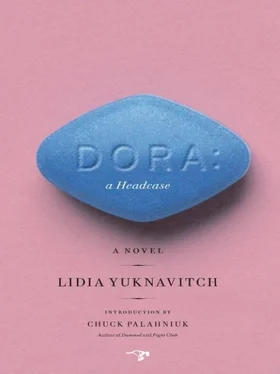Lidia Yuknavitch
Dora: A Headcase
This book is for every teen who ever got treated like something was wrong with them, when really they were opening the portal for all of us. I made this for you. Also, you are right. The adult world is a Fellini movie.
Crisis as Content: An Introduction
LEAVE IT TO LIDIA YUKNAVITCH TO TAKE US ALL TO THE next level.
It wasn’t that many years ago that rich people could get gussied up, wearing pearls and silver-buckled shoes, coats trimmed in ermine, diamond tiaras and velvet gloves and thus attired trot through lunatic asylums to watch the resident nutcases masturbate and eat feces. Such a bother, for the rich sane people, all that trotting, I mean. Nowadays, we simply recline on the sofa at home, sipping from our goblets of pinot noir. True, we’re forced to peel our own jumbo shrimp, but that’s the worst of it. Otherwise, we ogle the usual line-up of basket cases: There’s the compulsive hoarder, buried in heaps of squalid garbage and poo-sodden adult diapers. There’s the staggering, puke-glazed drunk or pill popper. There’s the always-entertaining sexual compulsive — that constantly jerking off, pussy paddling freak show. And there’s the obese food-gobbling blimp.
The biggest difference between our modern loony bin slumming and the more ancient practice is that these days we don’t have to smell the mess. It’s still an exhibition, but today we can observe it from the comfort of our living rooms. Yes, because now the crazies are televised. It’s “crises as commodity,” or — as I like to call it — “Thera-tainment.” Oh, the titles of the programs change, but the die is cast. The shows are called Intervention or Hoarders or Too Fat for Fifteen or Bad Sex . And the people appearing on them seem to do so because they have no private options left. Here are the same folks who’d be condemned to the public loony bin or the workhouse of an earlier century. The indigent town drunks or village idiots or neighborhood dirty old men.
Each television show is structured in three dramatic acts. In the first, we witness the vibrant, promising child. There are always baby pictures dredged up, primary school portraits of smiling kids wearing braces on their teeth. In the second act we see what this innocent tyke has become: a home-bound recluse, a bloated pig, a drooling junky, or a skulking porn addict. And in the third act the object of our voyeuristic gaze is offered stern redemption. In fact the entire show is marketed as a redemptive process. We’re only here to help. It’s with a sincere mask of empathy that we look down on these poor, troubled souls. In this final act, mental health professionals enter to teach coping skills and offer alternative methods of impulse control. It would all be so healthy and productive … except for the fact that the junkies are wired with microphones; everyone’s lower back has the square, tell-tale bulge of a mic pack hidden under his or her clothes. The fatties are gorging on fried chicken, sweating under bright camera lights. And always, unseen, is a crew of people staging every shot.
Worth mentioning here is how all this fuss undermines our concept of aberrant, self-destructive behavior as an illness. Watching Intervention or Hoarders the viewer can’t help but wonder if it’s not all a performance: fake symptoms met with fake therapy and resulting in a fake recovery. Here’s apparent proof that the mentally disturbed are, as we’ve always suspected, simply pretending in order to get more attention.
But, golly gee whiz, it’s all so … captivating. Really, there but for the grace of God go you and me. Without health insurance, that would be us parading our dirty psychiatric laundry to Dr. Phil and Dr. Laura, giving good Thera-tainment value in exchange for their scant advice. Plus a miserly ration of their tough love.
Most often the object’s ultimate fate is revealed with a single-card message. It’s a sentence or two presented in “reverse” type, white letters on a field of absolute black. Either the stricken sinner accepts the new teaching or they reject it. They live or die. Black or white. All or nothing. And most weeks, the fatty or junky or perv is saved. Hallelujah. But every so often … the meth-tooting zombie or ranting shut-in dies in the noxious bed of his or her own making.
It always was a kind of slumming: the sane descending to observe the insane, people with money and power staring at those without. It’s best not to mention the implied moral lessons about gluttony, lust, greed, and sloth pushed to their extreme, albeit so-deserved, fates. But it does suggest the Saved laying pitying eyes upon the Damned. In the same way we currently trawl cable channels for these train wrecks, no doubt the angels of Heaven will enjoy their eternity all the more because they’ll be granted the occasional stroll among those suffering in Hell.
What’s not to love? That’s Thera-tainment. It offers us a sense of superiority, comfort, catharsis. Each episode is less a melodrama than a cautionary tale or sermon. And the experts imported — the licensed clinical social workers, household organizers, personal trainers, dieticians, etc. — they’re nothing less than evangelical missionaries, these disciples of Freud and Jung and Skinner. On a side note, it’s ironic how the same institutions which confined the insane also protected them from such media exploitation. Remember the hue and cry over the Diana Arbus photos taken at Willowbrook? Where once only the rich could afford to pay the bribes or “donations” that gave them access to ogle, now everyone who can afford basic cable can enjoy the pathos.
So-called “reality television,” what started as merely observation (think of An American Family in the 1970s) and practical jokes (think of Candid Camera in the 1950s) was not about fixing people. Not at first. But now under the guise of empowerment, the scientific equivalent of a Billy Sunday tent revival, dozens of them, comes into our homes every week. So where do we go from here? Now that we’ve recognized the profit and status motives of these doctors, trainers, bullies, what’s next?
Leave it to Lidia Yuknavitch to show us.
Turnabout is more than fair play; it’s healthy. Perhaps as the weak “ill” subjects are exploited for Thera-tainment, perhaps now they’ll redirect the public gaze back, onto their “healthy” would-be rescuers. The exhibitors will become the exhibition. Only Lidia Y could see where this zeitgeist was going. In Dora , she takes the most classic model of Thera-tainment, personal-crisis-as-content, and she re-imagines it wonderfully reversed.
Imagine if Pat and Bill and Lance Loud had covertly decided to counter-manipulate filmmaker Craig Gilbert and public television. It’s easy to see how that would’ve reunited their unhappy family. Or, imagine if some poor sucker on a New York City sidewalk had slammed a cream pie into the smirking face of Allen Funt. That, that would be empowerment. An observed subject secretly, masterfully controlling the observer, that would demonstrate healthy self-actualization. As usual, Lidia Y is running miles ahead of the popular culture. We can’t say she hasn’t warned us.
The world of Dora is not just possible, it’s inevitable. It’s revenge as the ultimate therapy.
— CHUCK PALAHNIUK
Since eels do not keep diaries, the only way to determine gender was to cut and slice, but in vain, all the eels which I cut open were of the fairer sex.
SIGMUND FREUD, In search of male testicles in eels
It is fatal to be a man or woman pure and simple: one must be a woman manly, or a man womanly.
Читать дальше












